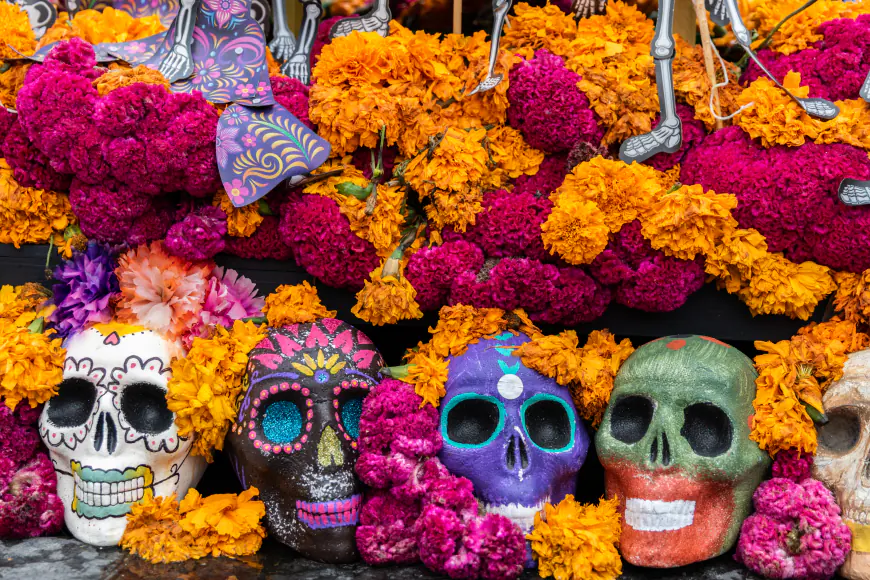When is Day of the Dead? What to know about Día de los Muertos
Halloween isn’t the only holiday taking place across America this week. While trick-or-treaters will flood Chicago area streets in costume on Thursday, Oct. 31, many soon after are preparing to celebrate a rich cultural tradition that originated in Mexico: Día de los Muertos. Día de los Muertos, or Day of the Dead, is a two-day celebration that is meant to reunite the living and the dead, and is often viewed as a celebration of life for loved ones who have passed away. Contrary to the mourning of most gatherings surrounding death, Día de los Muertos is viewed as a yearly occasion where the dead rejoin their families in celebration. Among the most recognizable features of Día de los Muertos celebrations are colorful skulls, often depicting death in a light-hearted and humorous way. From sugar candies and clay decorations to face painting, skulls, or calaveras, are the most ubiquitous component to the tradition. The celebration begins on Nov. 1 at midnight with “Día de los Angelitos” or “Day of the little angels,” where loved ones who died as children are believed to be reunited with their families for 24 hours. Oct 31, 2023 The Day of the Dead in Mexico is a celebration for the 5 senses Mexico Oct 24, 2023 ‘Day of the Dead': Everything you need to know behind the history of the Mexican tradition Mexico Oct 31, 2023 What is Día de los Muertos or Day of the Dead? The Mexican holiday that honors the dead During this time, an altar, known as an ofrenda, is accompanied by the child’s favorite snacks, toys and photographs to encourage a visit from their departed children. The names of the children are often written on a sugar skull. On Nov. 2 at midnight, “Día de los Difuntos” is celebrated to remember departed adults who are loved ones. While the night is often also a light-hearted celebration filled with laughter and memories, the ofrendas take on a decidedly more adult theme for Día de los Difuntos, with tequila, mezcal and pulque often included while playing games together. The culmination of the celebration then begins at noon on Nov. 2, when Día de los Muertos is officially celebrated, remembering the spirits of all of the departed. This part of the celebration is public, often featuring festivals in cities with parades and calavera painted faces in vibrant remembrance of loved ones. Cemetery visits are also common during this part of the holiday, when marigold flowers, gifts and sugar skulls with the departed’s name on them laid near the gravestone. At this time, it is also customary to clean the gravestone of the departed and restore its original color. According to Chicago’s National Museum of Mexican Art, Día de los Muertos began in the last 500 years as a combination of ancient indigenous cosmology and Roman Catholic tradition. The Día de los Muertos exhibit at the museum this year, “Where the Past is the Present,” is dedicated to Ray Patlán, a Chicago muralist and painter who died this April, the museum said. “Art is a reflection of society, and with this celebration, all those who have died from violence are remembered in this exhibition,” the museum said in a post. The museum is located at 1852 West 19th Street in Chicago’s Pilsen neighborhood.

Halloween isn’t the only holiday taking place across America this week.
While trick-or-treaters will flood Chicago area streets in costume on Thursday, Oct. 31, many soon after are preparing to celebrate a rich cultural tradition that originated in Mexico: Día de los Muertos.
Día de los Muertos, or Day of the Dead, is a two-day celebration that is meant to reunite the living and the dead, and is often viewed as a celebration of life for loved ones who have passed away.
Contrary to the mourning of most gatherings surrounding death, Día de los Muertos is viewed as a yearly occasion where the dead rejoin their families in celebration.
Among the most recognizable features of Día de los Muertos celebrations are colorful skulls, often depicting death in a light-hearted and humorous way.
From sugar candies and clay decorations to face painting, skulls, or calaveras, are the most ubiquitous component to the tradition.
The celebration begins on Nov. 1 at midnight with “Día de los Angelitos” or “Day of the little angels,” where loved ones who died as children are believed to be reunited with their families for 24 hours.
During this time, an altar, known as an ofrenda, is accompanied by the child’s favorite snacks, toys and photographs to encourage a visit from their departed children. The names of the children are often written on a sugar skull.
On Nov. 2 at midnight, “Día de los Difuntos” is celebrated to remember departed adults who are loved ones.
While the night is often also a light-hearted celebration filled with laughter and memories, the ofrendas take on a decidedly more adult theme for Día de los Difuntos, with tequila, mezcal and pulque often included while playing games together.
The culmination of the celebration then begins at noon on Nov. 2, when Día de los Muertos is officially celebrated, remembering the spirits of all of the departed.
This part of the celebration is public, often featuring festivals in cities with parades and calavera painted faces in vibrant remembrance of loved ones.
Cemetery visits are also common during this part of the holiday, when marigold flowers, gifts and sugar skulls with the departed’s name on them laid near the gravestone.
At this time, it is also customary to clean the gravestone of the departed and restore its original color.
According to Chicago’s National Museum of Mexican Art, Día de los Muertos began in the last 500 years as a combination of ancient indigenous cosmology and Roman Catholic tradition.
The Día de los Muertos exhibit at the museum this year, “Where the Past is the Present,” is dedicated to Ray Patlán, a Chicago muralist and painter who died this April, the museum said.
“Art is a reflection of society, and with this celebration, all those who have died from violence are remembered in this exhibition,” the museum said in a post.
The museum is located at 1852 West 19th Street in Chicago’s Pilsen neighborhood.
What's Your Reaction?








































































































